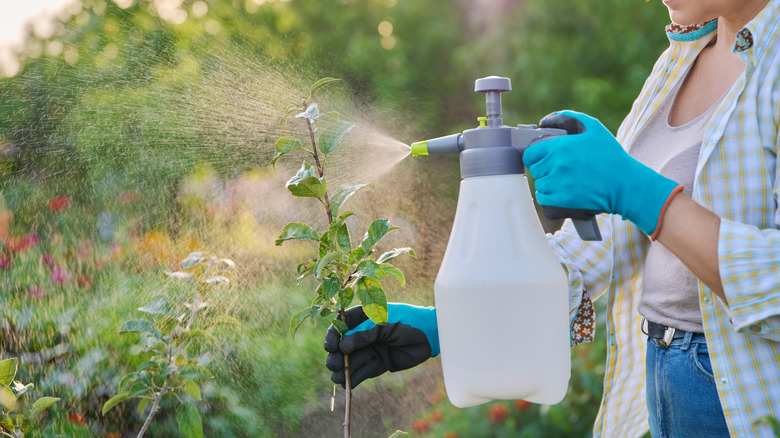How To Use Bonide Fruit Tree Spray And The Best Time To Apply It
We may receive a commission on purchases made from links.
Bonide Captain Jack's Fruit Tree Spray is a versatile commercial concentrate that helps combat common fruit tree diseases and pests, but how effective it is depends on whether you use it correctly for its intended purpose. Because it's sold in a concentrate form, you must mix the appropriate concentrate amount with water based on your specific need.
Once mixed, the best time to spray fruit trees is when the trees don't sit in direct sunlight, such as the early morning or late evening, to guard against leaf burn. You must also avoid spraying during active blossoming to protect pollinators and prevent damage to the growing fruit. The precise application timing and spray duration vary based on the tree and its harvest time, so it's essential you follow all product directions.
Described as four garden products in one, Bonide fruit tree spray combines fungicide, insecticide, miticide, and nematicide. As a spray, it offers a powerful defense against a variety of insects, such as aphids, mealybugs, weevils, Japanese beetles, and more, promising protection for up to three months. It also helps keep issues like powdery mildew, blight, rot, and leaf spot at bay. As a result, your fruit trees can bear a bountiful harvest in your yard, provided you follow these directions.
How to use and mix concentrated Bonide fruit tree spray
Before using your Bonide Captain Jack's Fruit Tree Spray concentrate, thoroughly shake it to ensure the pesticide contents aren't settled. Prepare the solution by diluting it with water at a temperature warmer than 45 degrees in a mixing tank or spray bottle. Each bottle of concentrate makes up to 20 gallons of solution. The amount of water you'll use depends on its intended use.
To address most insect conditions, start with 1½ to 3 tablespoons of concentrate per 1 gallon of water. Increase it to 4½ tablespoons of concentrate for a heavy infestation. However, for disease control, you'll use 3 to 4½ tablespoons, and you can increase to up to 6 tablespoons for treating the soil.
If using a 32-ounce (1 quart) spray bottle, the ratios are slightly decreased. Mix 1⅛ to 2¼ teaspoons for regular insect conditions, or 3½ teaspoons for heavy infestations. If you need to control disease in your fruit trees, use 2¼ to 3½ teaspoons, and for soil treatment, 2¼ to 4½ teaspoons. After combining the concentrate with the correct amount of water, shake it again thoroughly. Then it's time to apply.
Timing and safety tips for Bonide fruit tree spray
You'll need to pay close attention to your fruit tree's growth stage to determine when it's safe to spray. Before using it for the first time, test it on a small leaf before you treat the whole plant to evaluate any adverse effects. Per the manufacturer's guidelines, spraying during the dormant stage is ideal for getting rid of overwintering pests, but don't spray if the weather is below 40 degrees.
You can make a subsequent application anytime between when your trees are in a green tip stage and when the blossoms reach full color. Once the blossoms open, however, it's crucial you avoid spraying. Bees and other insect pollinators will be active during this period, and Bonide fruit tree spray can be toxic as they forage. After the bees retreat and the blossoms shed all of their petals, you can follow with a third application. Finally, once your trees actively bear fruit, you can spray a fourth application, following up as needed every seven to 14 days through the growing season.
Always practice the safe use of Bonide pesticide and fungicide by wearing protective gear, including gloves and eye goggles. Never apply when temperatures are over 90 degrees or during rain, or near a body of water, as this product is highly toxic to fish. Store it in a cool, ventilated place in its original container, and don't reuse the container after it's empty. After spraying, keep children and pets away. Due to regulations, Bonide fruit tree spray is restricted and can't be sold in South Dakota, Vermont, or Puerto Rico.


